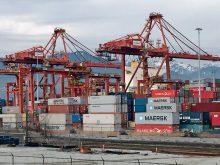WINNIPEG – The United States is entering uncharted territory – a full-blown trade war with Europe, China, Canada, Mexico and a list of other nations.
Today, March 12, President Donald Trump imposed global tariffs of 25 percent on steel and aluminum tariffs from dozens of countries.
Follow all our coverage of the tariffs situation here
Read Also

Exports off to a slow start after last year’s torrid pace
Canadian grain, oilseed and pulse exports are off to a slow start, but there are some bright spots, according to the Canadian Grain Commission’s most recent weekly export data report.
The trade war may escalate April 2, as the president intends to introduce reciprocal tariffs on any country that has duties on American goods.
April 2 is more than two weeks away, which is a long time given the current environment, so any outcome is possible.
Still, Trump is attacking the economic future of approximately two billion people, which has never been tried before.
Despite the chaos and risk of retaliatory tariffs, some American farmers are not worried. They believe Trump will provide ‘trade aid’ to fully compensate producers for any and all losses.
It could play out that way, but some agricultural economists are skeptical.
“My advice would be: don’t put all your eggs in the trade aid basket,” said Scott Gerlt, chief economist for the American Soybean Association, to a crowd of farmers at the Commodity Classic in Denver March 4.
“I think there’s an expectation… that this will happen. It happened last time…. (But) there is a lot of uncertainty there.”
During the last Trump presidency, America and China engaged in a tit-for-tat trade skirmish. In 2018-19, the American government made USD$28 billion in payments to farmers to offset lost sales of soybeans and other commodities to China.
U.S. Agriculture Secretary Brooke Rollins has suggested that the government could replicate those payments in 2025.
Gerlt wonders if Trump can do that, without the approval of Congress.
Previously, the U.S. Department of Agriculture used the Commodity Credit Corporation, a government owned entity, to make payments to farmers. The Trump Administration might follow that playbook, again, but the CCC could be out of money, Gerlt said.
Media reports suggest the CCC has only $4 billion in available funds.
“If the Administration would go (for) a very large trade aid package, they would likely have to rely on Congress to replenish that fund,” Gerlt said.
The Republicans have firm control over the Senate, but the House of Representatives is a different story.
As of early March, the Republicans had 217 votes and the Democrats 215, said Joe Dagher, head of public affairs for Farm Credit, which supports rural America and agriculture.
“The Republicans barely have control of the House… and that’s pretty challenging.”
Politics aside, things could get complicated if farmers and farm groups grow weary of these trade battles and push back on Trump-onomics.
“We want trade, not aid,” said Krista Swanson, lead economist for the National Corn Growers Association.
Contact robert.arnason@producer.com


















